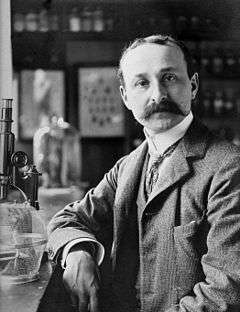George Nuttall
| George Nuttall | |
|---|---|
|
George Nuttall in 1901 | |
| Born |
5 July 1862 San Francisco |
| Died | 16 December 1937 (aged 75) |
| Nationality |
United Kingdom United States |
| Fields | bacteriology |
| Institutions | University of Cambridge |
| Alma mater | University of California (M.D.) University of Göttingen (Ph.D) |
George Henry Falkiner Nuttall FRS[1] (5 July 1862 – 16 December 1937)[2][3] was an American-British bacteriologist who contributed much to the knowledge of parasites and of insect carriers of diseases. He made significant, innovative discoveries in immunology, about life under aseptic conditions, in blood chemistry, and about diseases transmitted by arthropods, especially ticks. He carried out investigations into the distribution of Anopheline mosquitoes in England in relation to the previous prevalence of malaria there. With William Welch he identified Clostridium perfringens, the organism responsible for causing gangrene. He also demonstrated the importance of intestinal bacteria in digestion and investigated the bactericidal properties of blood.
He was born in San Francisco to a British father, who was a doctor, and an American mother from California, and was the brother of Zelia Nuttall. He acquired British citizenship in 1900. He gained an M.D. from the University of California in 1884 and a Ph.D. from the University of Göttingen in 1890. In 1899 he moved to England, where he stayed for the rest of his life, and became associated with Cambridge University. In 1906 he was elected the first Quick Professor of Biology at Cambridge (emeritus 1931).
He founded the Molteno Institute Biology and Parasitology at the University of Cambridge and directed it from 1921. Nuttall established and edited the Journal of Hygiene in 1901 and also founded and edited Parasitology in 1908.
His writings include some 150 articles in professional journals.[4]
He published:
- Hygienic Measures in Relation to Infectious Diseases (1903)
- Blood Immunity and Blood Relationship (1904), establishing the identification of different kinds of blood
- The Bacteriology of Diphtheria (1908), with Graham Smith and others
- Ticks (1908 et. seq.), with C. Warburton and others
- The Drug Treatment of Canine Piroplasmosis (1910)
- Russian Ixosoidea (1912)
- The Training and Status of Public Health Officers in the United Kingdom (1913)
Parasites named for him
- Nuttallia — Small protozoan parasites found in the red blood corpuscles of horses and dogs.
- N. equi, a species causing hemoglobinuric fever of horses in South Africa. It is probably transmitted by the tick Rhipicephalux everti. Called also Babesia equi and B. caballi.
- N. gibso'ni is found in dogs.
References
- ↑ Graham-Smith, G. S.; Keilin, D. (1939). "George Henry Falkiner Nuttall. 1862-1937". Obituary Notices of Fellows of the Royal Society. 2 (7): 492. JSTOR 769002. doi:10.1098/rsbm.1939.0009.
- ↑ k., D. (1938). "Prof. G. H. F. Nuttall, F.R.S". Nature. 141 (3564): 318–319. doi:10.1038/141318a0.
- ↑ "The Oxford Dictionary of National Biography". 2004. doi:10.1093/ref:odnb/35271.
- ↑ New International Encyclopedia
Further reading
| Wikimedia Commons has media related to George Nuttall. |
- Dorland's Medical Dictionary (1938)
-
 This article incorporates text from a publication now in the public domain: Gilman, D. C.; Peck, H. T.; Colby, F. M., eds. (1905). "article name needed". New International Encyclopedia (1st ed.). New York: Dodd, Mead.
This article incorporates text from a publication now in the public domain: Gilman, D. C.; Peck, H. T.; Colby, F. M., eds. (1905). "article name needed". New International Encyclopedia (1st ed.). New York: Dodd, Mead.
